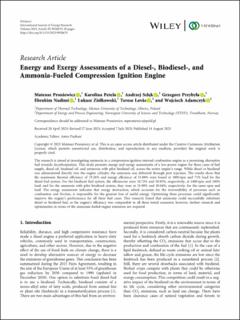| dc.contributor.author | Proniewicz, Mateusz | |
| dc.contributor.author | Petela, Karolina | |
| dc.contributor.author | Szlȩk, Andrzej | |
| dc.contributor.author | Przybyła, Grzegorz | |
| dc.contributor.author | Nadimi, Ebrahim | |
| dc.contributor.author | Ziółkowski, Łukasz | |
| dc.contributor.author | Løvås, Terese | |
| dc.contributor.author | Adamczyk, Wojciech | |
| dc.date.accessioned | 2024-01-16T13:22:51Z | |
| dc.date.available | 2024-01-16T13:22:51Z | |
| dc.date.created | 2023-10-03T13:42:58Z | |
| dc.date.issued | 2023 | |
| dc.identifier.citation | International Journal of Energy Research. 2023, 2023 . | en_US |
| dc.identifier.issn | 0363-907X | |
| dc.identifier.uri | https://hdl.handle.net/11250/3111872 | |
| dc.description.abstract | The research is aimed at investigating ammonia in a compression ignition internal combustion engine as a promising alternative fuel towards decarbonization. This study presents energy and exergy assessments of a low-power engine for three cases of fuel supply, diesel oil, biodiesel oil, and ammonia with pilot biodiesel oil, across the entire engine’s range. While diesel or biodiesel was administered directly into the engine cylinder, the ammonia was delivered through port injection. The results show that the maximum thermal efficiency of 33.56% and exergy efficiency of 31.88% were found at 1800 rpm and 71% load for the diesel fuel system. For the biodiesel fuel system, the efficiencies were 32.72% and 30.93%, respectively, at 1800 rpm and 100% load, and for the ammonia with pilot biodiesel system, they were at 31.98% and 30.04%, respectively, for the same rpm and load. The exergy assessment indicates that exergy destruction, which accounts for the irreversibility of processes such as combustion and friction, is responsible for the greatest loss of useful energy. Optimizing these processes could significantly improve the engine’s performance for all three fuel cases. This research found that ammonia could successfully substitute diesel or biodiesel fuel, as the engine’s efficiency was comparable in all three tested scenarios; however, further research and optimization in terms of the ammonia-fueled engine emissions are required. | en_US |
| dc.language.iso | eng | en_US |
| dc.publisher | Hindawi | en_US |
| dc.rights | Navngivelse 4.0 Internasjonal | * |
| dc.rights.uri | http://creativecommons.org/licenses/by/4.0/deed.no | * |
| dc.title | Energy and Exergy Assessments of a Diesel-, Biodiesel-, and Ammonia-Fueled Compression Ignition Engine | en_US |
| dc.title.alternative | Energy and Exergy Assessments of a Diesel-, Biodiesel-, and Ammonia-Fueled Compression Ignition Engine | en_US |
| dc.type | Peer reviewed | en_US |
| dc.type | Journal article | en_US |
| dc.description.version | publishedVersion | en_US |
| dc.source.volume | 2023 | en_US |
| dc.source.journal | International Journal of Energy Research | en_US |
| dc.identifier.doi | 10.1155/2023/9920670 | |
| dc.identifier.cristin | 2181345 | |
| dc.source.articlenumber | 9920670 | en_US |
| cristin.ispublished | true | |
| cristin.fulltext | original | |
| cristin.qualitycode | 1 | |

